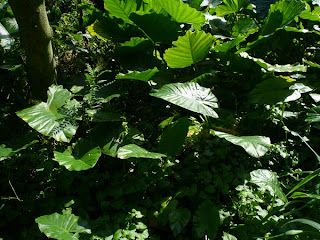 Sitting here on my window seat I can see Disneyland when I look to the right. Space Mountain shows among the trees; the fast ferries pass on their way from Central Hong Kong to this perfectly groomed area that I live in.
Sitting here on my window seat I can see Disneyland when I look to the right. Space Mountain shows among the trees; the fast ferries pass on their way from Central Hong Kong to this perfectly groomed area that I live in.But when I look to my left, I see the old ferries that go out to other outlying islands and a cement walkway leading to Nim Shue Wan. I suppose since there is a name for the place, it isn't only squatters living in the ramshackle cobbled-together buildings. But I know a lot of the places aren't titled. The first time I walked the path, it was pretty creepy. The path leads between houses with glass cemented into the top of the walls, around the awning cooking areas that have karaoke set up on Sunday, and in some places actually through people's houses.

In two places, people have a house on the right side of the path, then on the left they have a table and cooking area. The area is joined by a corrugated fiberglass roof, and the designated, cemented pathway to the Trappist Monastery (the kind of hike that is in Lonely Planet) goes right through. There are always two or three dogs lying in that shady area and no way to go around, so the only thing to do is just go on. I always think I should say "Afiyet olsun" or "Bon appetit" or something when the families are sitting eating dinner, but I don't know what to say in Cantonese. I've never taken a picture of the inside of the house because I feel weird enough walking through. Some time that no one is home, maybe I can, but I've never been by when it was deserted.
There are garden plots growing bok choi protected from the birds by CD's dangling from red cords. There are big banana groves. I saw a huge black snake on the path once there. The dogs that live in the houses sometimes follow us along as we leave their house and then go off exploring in the bananas. There's a Tin Hau temple and several shrines along the way towards the monastery.
All along the path there are also government signs. They say, "The areas in the vicinity of this sign are subject to landslip risk. Some squatter huts have been recommended for clearance. Locations of the affected squatter huts are available from the Geotechnical Engineering Office at 2760 5715. Please stay away from slopes and stream courses during Landslip Warning Signal, Typhoon Signal No. 8 or heavy rains. For location of temporary shelters, you may call..." I always thought it was kind of benevolent of the government to put up the signs, but this winter, the government did more. Along one section of this "village" the hillside climbs steeply up. So the government built retaining walls behind a bunch of the "huts." It was an elaborate project that took several months and required the boating in and landing of generators, corrugated iron fences, concrete mixers, etc. None of the homes were destroyed either: the workers just went around them. I don't know many governments that would do that for squatters.
 Part of the village has been taken over by Filipino workers who don't live-in with their employers, or maybe workers that aren't under contract and so have a more tenuous existence. On Sunday morning (their only day off) great pots of food are started cooking in the open kitchens, and big TV screens with karaoke screens are getting readied for big afternoon parties. I can hear the music some nights from my room. From this sign it looks like lots of services are offered in that warren of buildings. On Sundays also there is an unofficial flea market on the way to Nim Shue Wan where some helpers sell clothes and shoes that have somehow come down to them from their employers'.
Part of the village has been taken over by Filipino workers who don't live-in with their employers, or maybe workers that aren't under contract and so have a more tenuous existence. On Sunday morning (their only day off) great pots of food are started cooking in the open kitchens, and big TV screens with karaoke screens are getting readied for big afternoon parties. I can hear the music some nights from my room. From this sign it looks like lots of services are offered in that warren of buildings. On Sundays also there is an unofficial flea market on the way to Nim Shue Wan where some helpers sell clothes and shoes that have somehow come down to them from their employers'.This little area to my left is a very different kind of life from the view to the right. Sometimes at the flea market, a helper has her little charge with her while she's shopping. I always wonder if the mom knows where her child has been and the different perspective the child has seen.










